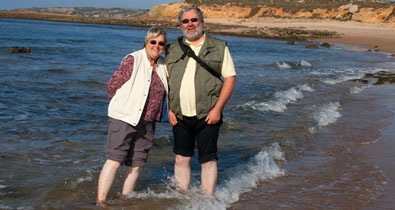Sunday 9th March 2014.
A housework day today, we (by that I mean Sue) has done all the washing and the very small amount of ironing while I worked hard mucking about with the computer.
From the campsite we had a walk through a cork oak wood. It was very peaceful and during our hour or so walk saw just one other couple walking a dog and heard nothing other than bird song - quite delightful. The countryside here is far different from other parts of Portugal we have visited. Despite the high hills on which are built forts and castles it is a much softer landscape that puts us in mind of the south downs.
As we are re-enthused by moving we got the barbie out and did a paella tonight. It was one of my better efforts and went down very well with a chilled bottle of white port.
The t’internt is good here so we were able to watch the news on BBC and then (via XBMC and Icefilms) watched a new release film
Monday 10th March 2014.
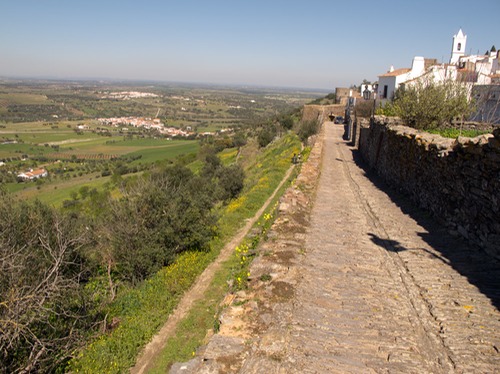
Paid a visit to the tiny walled town of Monsaraz today, perched high above the River Guadiana on the frontier with Spain. The castle keep commands glorious views in all directions and at it’s foot the garrison courtyard which today serves as a bullring. The town is first and last a tourist attraction with it’s only shops selling souvenirs or coffee or both. Despite this the three shopkeepers we spoke to (one English, one French and one Portuguese) all loved the town and enjoyed chatting to the tourists and not just about the town. The Portuguese lady told us all about family life in Portugal, and of the family meals that involve three or four hours sitting around the dining room table. The prices they each charged were very reasonable indeed, Sue bought a beautiful handwoven (in the shop) marino wool scarf for just €15.00 (£12.51) and a tea, a coffee and large cheese/ham pastry rolls next door came to the very reasonable sum of €5.20 (£4.35). The town itself was a gem with extensive views over the largest man made reservoir in Europe. Very unusually for us (we generally don’t buy souvenirs) as well as the scarf we purchased a plate made in the local pottery and painted by the local policeman, to supplement his low wages. The wages, particularly of civil servants, have been cut quite dramatically as part of the austerity measures and although, for example, the cost of meals out is great for us for the restaurant owners it is a nightmare trying to keep prices down with many costs including IVA (now at 23%) rising.
From Monsaraz we went on to see Cromeleque do Xerez a stone circle of 49 granite stones with a 4m high central menhir, which is said by Rough Guide to Portugal to be the site of Neolithic fertility rites. In fact the circle is actually a square and have been on this site only since being moved to prevent them disappearing under water when the reservoir was flooded.
We have had news that sister Pam is still improving and (subject to house alterations) may be allowed home on Friday. We don’t know if this is just for the weekend or for a longer period but it is heartening news anyway.
Tuesday 11th March 2014
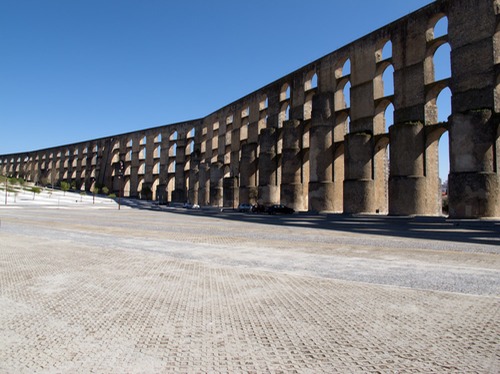
Sue has been through the guide books and came up with quite an itinerary for the next few days. Today was first Elvas, whose main claim to fame is a 6km long aqueduct that supplied the city with pure water; it was begun early in the 15th century and completed in 1622. For some distance it includes four tiers of superimposed arches, with a total height of 40 m.
Its historical strategic position made Elvas the first frontier city to be permanently fortified after independence from Spain was restored. Between1645 and 1653 a new fort was built over the previous ones using the Dutch method. Composed of seven bastions and four half bastions, the final structure is considered to be one of the largest and best preserved bastion fortifications in the world with a perimeter, much of it walkable, of over ten kilometres.
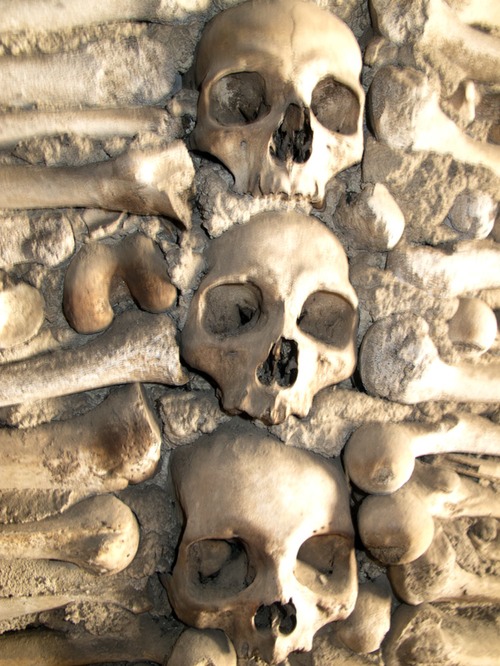
Campo Maior our second stop of the day was marked by our second encounter with policemen of this trip. We had stopped in a cafe for a coffee and to ask the way to the chapel we wanted to see. We turned out to be just 100m or so from where we wanted so after our coffee and empinadas (ham/cheese pastry roll and a chicken pie resembling a pork pie) we wandered down the road. Before we had gone 50m two policemen in a police car stopped along side asking where were we going (we think), we said the name of the chapel. Do you know exactly where it is (we think)? they asked. We mimed turning right at the road we could see a few metres further on. Be careful and avoid gypsies (we think) they said and giving us big smiles and a cheerful wave drove away. Our TOURIST HERE sign must have been shining good and bright. Two minutes later un-harassed by gypsies we arrived at the chapel and charged entry of 50 cents each by a grumpy cleric. In 1732 disaster struck the town when a gunpowder magazine, ignited by lightning, destroyed the citadel and killed some 1500 people. It seems that the victims provided the material for the Cappella dos Ossos, built in 1766 and entirely faced with human bones and bears an inscription on mortality spelt out in collar bones.
On the way back to the campsite we were lucky enough to see a couple of Alter Real - Horse of Kings being exercised. The Portuguese national breed of horse Lusitano are grey but those called Alter Real are purebred bay or brown. King Jose (1750 - 1777) who yearned for a quality Portuguese horse imported a stock of Andelusian mares from which the gracious nimble Alter Real was bred.
Still with energy after a long day we cooked fidua on the BBQ, its like a paella but made with pasta rather than rice. It was delicious with a bottle of chilled white port to accompany it.
Wednesday 12th March 2014.
Although we still had to use the car we stayed local today and visited the castle that can be seen from the campsite. It’s only just over 6km so we could have taken our bikes but a lot of it seems to be straight up - so car it was. We parked just outside the town gate and walked into what seemed like a “Hitchcock” film set. The village was deserted and silent, we walked up the steep street to the castle keep seeing no-one, entering the keep two ladies bared the way requiring €2 from each of us before allowing entry. The eye catching castle, its walls bound by bold stone “ropes”, replaced an earlier castle that fell in an earthquake in 1531. The 16th century walls have at some point been unsympathetically clad in concrete render.
During our trip today we were amazed to see a “flock” of storks, numbering some 50 plus specimens circling above us. Quite a sight!
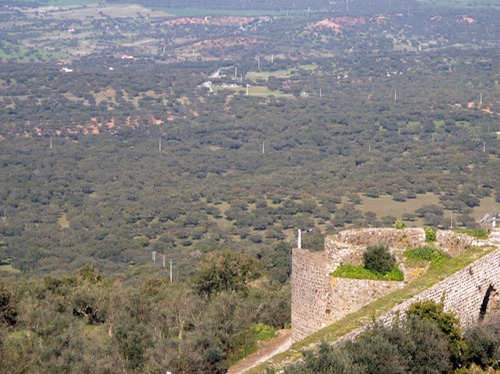
Thursday 13th March 2014
We had long looked forward to visiting Evora, the guide books had much to say about it the DK Eyewitness Travel Guide calling it “an enchanted city”. Enchanted my eye! We saw (from our point of view) just two things of interest, the first being the roman temple built in the 2/3rd century AD. It was put to a number of uses including armoury, execution site during the inquisition and slaughterhouse before being rescued in 1870. It was OK but there was no access and with lots of kids from the local school milling about with iPods and the like photos were not easy. Our next point of interest in Evora was not even mentioned in the DK Eyewitness Guide - the Cappella dos Ossos or Chapel of Bones. During the fifteenth and sixteenth centuries there were 42 monastic cemeteries in town which took up much needed space. The Franciscans solution was to move all the remains to one compact consecrated site, the Cappella dos Ossos. “ . . . A timeless and gruesome memorial to the mortality of man the walls and pillars the chilling chamber are entirely constructed from the bones of more than 5,000 monks. There is a grim humour in the ordered, artfully planned arrangement of skulls, tibias and vertebra, around the vaults and in the rhyming inscription over the door which reads Nos ossios que aqui estamos pelos vossos esperamos (We bones here are waiting for your bones) . . . “ *(1)
Leaving Evora we next went to Arraiolos the centre of Portugal’s carpet making, where you can see carpets being made in the traditional way. Unfortunately Portugal’s tourist industry is closed on Mondays (and in some places Tuesday morning also) and every industry, except catering, closes daily for 2 to 2.1/2 hours. Mealtimes are almost a religion here and lunch is no exception. We arrived at noon. Arraiolos was closed. We went to a café for coffee and pasties (€4.60 for two coffees and two pasties - how cheap is that!!) and then went for a look around the castle, which had unrestricted access, to pass the time but with less than two hours gone we decided to come back another time. The castle’s vegetation proved to be a good habitat for different butterflies (see photos).
Friday 14th March 2014
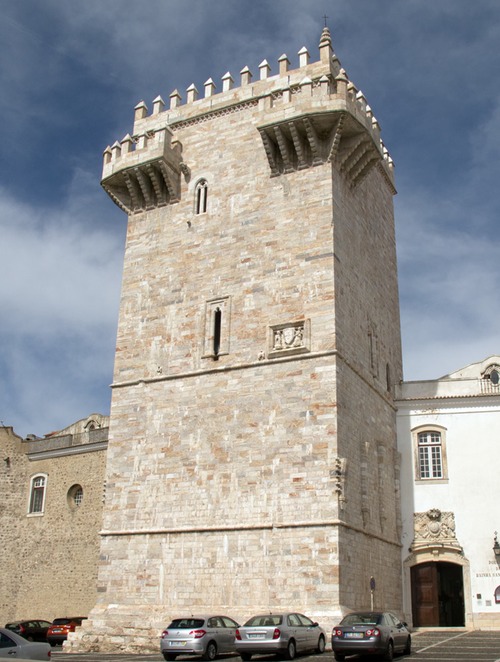
Local again today, well localise anyway. We went to Estramoz the nearest town of any significance to the camp site is around 12 km away and is reached through extensive vineyards as this is an important wine region. Another other important local industry (as said in last weeks blog) is marble. It has made the area prosperous as well as beautiful but the scars of the quarries does little for the approaches to the town. The town itself however is quite spacious and open once through the small gateways. Parking in the huge town centre car park we walked steadily upwards through the steep streets till we reached the old fortifications now the Pousada da Rainha Santa Isabel. The medieval upper town is dominated by a 13th century keep rising 27m (89ft) and clad if not made of marble. Access to the keep is, via the pousada, free and allows superb views in all directions.
Saturday 15th March.
Boring, boring, boring. Why do we have to do laundry and housework every week???
*(1) Rough Guide to Portugal
